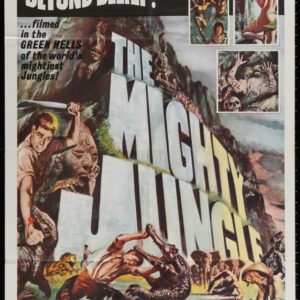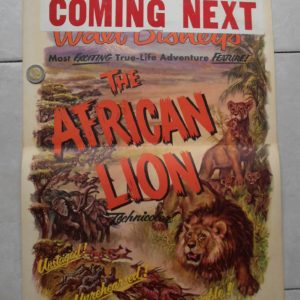Description
Original 1965 US insert, used, folded (36 x 91 cm)
The Naked Prey is a 1965 adventure film starring Cornel Wilde, who also served as director and producer, which was released by Paramount Pictures. Set in the South African veldt, the film is a wilderness survival story loosely based on the experiences of explorer John Colter, who was pursued by Blackfoot warriors through frontier Wyoming in 1809. The screenplay earned Clint Johnson and Don Peters an Academy Award nomination.
Plot summary
Wilde, whose character is never named, plays a professional safari guide leading two white men (Gert van den Bergh and Patrick Mynhardt) and their troupe on an elephant hunt through the African veldt during the colonial era. When the group intrudes on a local tribe’s territory, some natives accost them, expecting to be bought off with gifts. Although the guide advises his client to be courteous, warning “they could give us a bad time,” the client refuses to offer anything and insults the natives, sending them away empty-handed. Later, the tribe returns en masse, captures the entire party, and puts the captives to death, using various cruel and unusual methods. One man is covered in clay and roasted alive on a spit; another is tarred, feathered, and trussed, then chased and killed by all the women. The man who insulted the tribesmen is trapped in a ring of fire with a venomous snake.
Wilde’s character is spared until the last. He is stripped naked and then an arrow is fired into the air. Wilde’s character then runs and once he passes the arrow is chased by one tribesman who must reach the arrow before the next tribesman can join in the hunt. His pursuer throws a spear at him and misses, which he uses to kill his pursuer and take his supplies. Wilde’s character then flees, and a multi-day chase ensues. One by one, the pursuers fall; either killed by the guide, or taken out of the chase by wild animals. He eventually finds food and water, though initially forced to eat a snake after several failed hunts. Eventually, he comes across a village and camps nearby, only to be awoken by the gunfire of slavers of African descent.
Amidst the chaos of the melee, he meets an African girl who is hiding from the slavers. With the slavers closing in on their location, he runs out for the sake of diversion. He eventually escapes at a river, but nearly drowns in the process. Luckily, the girl from earlier finds him on the river bank and coaxes the water out of his lungs. She travels with him for a day or two, and as they walk along, he sings a nineteenth-century drinking song, “Little Brown Jug”. The child sings a song in her own language. and they then attempt to sing each other’s songs. They part ways near a village, and some time later the guide returns to a colonial fort just seconds ahead of his pursuers. As he reaches safety, the man turns and exchanges a salute with their leader (Ken Gampu).
Production and critical reception
Setting
The Naked Prey was filmed on location in Southern Rhodesia (Zimbabwe). The initial version was set in the American Old West and more closely resembled the incident that inspired it; however, financial concerns persuaded Wilde to change the setting to Africa.
Cast notes
Wilde was an athlete; he qualified for the Olympic Games as a fencer in 1936 and remained in excellent condition. However, he was over 52 years old when the movie was shot and was sick during much of the filming, but pressed on, saying the illness added to his performance.
Five of the ten actors playing tribal hunters were cast together in the 1964 South African film Diamond Walkers.
In the original theatrical release there is a very long shot with Wilde in the mid foreground and way in the distance, a mile or so behind him, one can see a tiny Land Rover crossing the screen on the horizon.
Critical reception
The minimal dialog, richly realized African settings, and emphasis on making “the chase (and violent combat along the way) a subject unto itself, rather than the climax to a conventional story” distinguish Naked Prey as an innovative and influential adventure film. However, although it is considered a small classic today, it received mixed reviews at the time of its release. Robert Alden of The New York Times, reacting to the brutality of some of the early scenes, dismissed the film as “poor and tasteless motion-picture entertainment”, but did acknowledge its “authentic African setting” and “effective use of tribal drums and native music.” Roger Ebert, taking a different tack, called The Naked Prey “pure fantasy” of the “great white hunter” variety, adding disdainfully: “Sure, it’s nice to think you could outrun half a dozen hand-picked African warriors simply because you’d been to college and read Thoreau, but the truth is they’d nail you before you got across the river and into the trees.”
Other reviewers, however, were more enthusiastic. In Time, the film was described as “a classic, single-minded epic of survival with no time out for fainthearted blondes or false heroics” where “natives are not the usual faceless blacks but human beings whose capacity for violence the hero quickly matches.” The Variety reviewer praised the documentary-style use of nature photography to show “the pattern of repose, pursuit, sudden death and then repose” that characterises the entire chase.
On review aggregator website Rotten Tomatoes, the film holds an approval rating of 86% based on 14 reviews, with an average rating of 6.93/10.
Later releases
The Naked Prey was released on DVD by The Criterion Collection in January 2008.
Soundtrack
The soundtrack consists of African tribal chants, natural sounds, and occasional dialogue, in English and otherwise. There are no subtitles, and incidental music is mostly absent. It features Nguni tribal songs specifically recorded for the film. A vinyl LP The Naked Prey was released in 1966 on Folkways Records. It was re-released as Cornel Wilde’s The Naked Prey in CD form on Latitude/Locust Music in 2004.
Comic book adaption
Dell Movie Classic: The Naked Prey (December 1966)
Cinematic influence
As teenagers, Joel and Ethan Coen shot their own version of The Naked Prey on a Super 8 film camera. They called it Zeimers in Zambia and cast neighbor Mark Zimering in the lead role.
Mel Gibson’s film Apocalypto resembles The Naked Prey in its plot and in several similar scenes. The scenario of a man being pursued by a pack of warriors who set out, one by one, after he has reached the point where a loosed arrow fell was seen also in the 1957 film Run of the Arrow.
Likewise, Robert Redford’s movie Jeremiah Johnson has a similar plot line where Native American tribesmen give chase often, individually, to challenge Redford’s character (Jeremiah Johnson) to duel to the death. Similarly, he signs off with the chief from a distance at the end of the movie.
Cultural influence
The progressive rock group Coheed and Cambria was originally named Shabütie after the African chant from the film. Shabütie translates to “Naked Prey”.
In popular culture
In the first scene of the Mad Men season 5 episode, “Far Away Places,” Abe coaxes a distracted and reluctant Peggy to go see the film with him. His pitch: “You’re resisting a chance to see Cornel Wilde naked? I heard he wrestles a boa constrictor. Sounds pretty dirty.”
The 266th episode of Cheers is titled “Bar Wars VII: The Naked Prey.”
In the movie Where’s Poppa?, the main character’s brother (played by Ron Leibman) is regularly mugged while taking a shortcut through Central Park. In one mugging, the group of muggers refer to The Naked Prey as they strip him and then chase him. Garrett Morris plays one of the muggers.
Directed by Cornel Wilde
Produced by Cornel Wilde, Sven Persson
Written by Clint Johnston, Don Peters
Starring: Cornel Wilde, Ken Gampu, Patrick Mynhardt, Bella Randels, Gert van den Bergh
Distributed by Paramount Pictures
Release date: 3 June 1965
Running time: 96 mins.
Country: Rhodesia, United States




